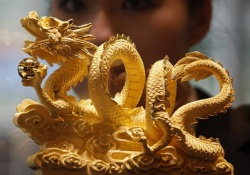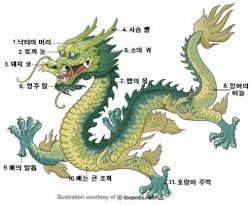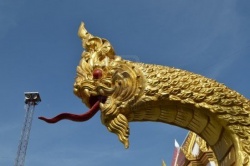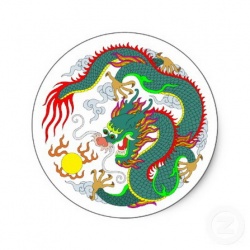Dragons
Dragons in Royalty dragons: They are powerful living beings who unlike humans can exist in different realms with some belonging to the heavenly realms and some to either the animal or spirit realms. There are both beneficial and malevolent types.
The ruler of China, or the emperor, is greatly affected by the dragon. He sleeps on a dragon bed, sits on a dragon throne, and even has a large dragon-shaped boat. The official decoration of the royal robe is the five-toed dragon. The emperor's robes often have a dragon on it that is trying to swallow the sun. This is to show that it is as impossible to bribe him as it is for a dragon to swallow the sun. A long time ago if anyone but the emperor wore the five-toed dragon on their Clothes, they would be beheaded with little notice whatsoever.
The first emperor was believed to have a dragon's tail. For hundreds of years, Chinese emperors have sat behind bamboo curtains because it was said that they could change into dragons at will. Seeing a dragon meant that their ruler was doing a good job. Emperors are said to have connections to dragons- some even claim to be their descendants. In fact, the dragon is considered so wise, they have been royal advisors. The dragon gets angry when a ruler does not follow his advice. Because of this, it may stop bringing rain or even cause flooding.
Before history began, China's first emperor, Fu Hsi was said to have had a dragon’s tail. Fu Hsi also was given the Knowledge of Writing by a dragon. Shen Nung, the emperor after Fu His, was said to have a dragon as a father. Huangdi and Shun who were the royal forerunners to these emperors were said to have had dragon blood running through their veins. Yu, who was the founder of the Xia dynasty in about 2,000 B.C. was said to have been born a dragon and to have possessed supernatural powers.
The royal family was said to be the only people allowed to eat the meat of dragons. It is said that it will make you smarter. Dragons act as advisors to the royal families. These royal families can only go to certain dragon spots. All dragons have one main king that they serve. That King did not reveal himself to the Chinese people. The Celestial King keeps the sky from falling. The Spiritual King controls wind and rain. The Earth King controls rivers and streams. King of Hidden Treasures guards the underground. There are five kings that rule the north, east, south, west and central seas.
In Chinese legends, the dragon gets its Power from the Pearl of Wisdom. It keeps his Pearl (and perhaps other treasure it may be guarding) under its chin. It is believed that the Pearl of Wisdom can multiply anything it touches. For example, if you put the Pearl of Wisdom in your wallet that has a dollar in it, the next day your wallet would be overflowing with $1 bills. This Pearl can represent Thunder, by being depicted as a swirl, or it can even be the moon, sun, or an egg.
1. Iron- dragons are afraid of iron because you can supposedly slay a dragon with a magical iron sword, needle, or wand.
2. Centipedes- Dragons fear centipedes because centipedes can crawl up a dragons nose and eat it's brains out.
3. Tigers- Dragons have a phobia of tigers because they are the only Animals which are as powerful as the dragon. Some have gotten in fierce battles with dragons. Some famous dragon slayers are also known to be half tiger.
4. Fire- Chinese Dragons are afraid of Fire because it is the one element that they are not in tune with (western dragons are afraid of water).
Chinese dragon Types
There are nine major types of oriental dragons. They are:
- Horned - these are the most powerful of the Chinese Dragons; they have horns and are deaf
- Tien Lung- Celestial - these are the dragons that represent the Chinese culture; they guard the gods and the emperors
- Shen Lung- Spiritual - this type of dragon guards sacred places from Evil demons; he controls wind and rain
- Dragon of Hidden Treasures -Dragons like this guard hidden and sacred treasures, such as the Pearl of Wisdom; controls earthquakes and volcanic eruptions
- Yellow - many myths and legends were made about the Yellow Dragon;
- Dragon King – There are four dragon kings. One for each of the 4 seas; the North, South, East, and the West dragon
Dragons in Royalty
Symbol for All
The Chinese dragon was looked upon by the Chinese people as the ultimate Symbol of good Fortune (abundance and prosperity). A Chinese dragon was a divine bringer of rain, which was a necessary for the good of all. Rain Rituals started about the fifth century BC with a dragon image animated by a procession of dancers. If someone saw a Chinese dragon, it was a good sign, letting the people know their ruler was doing a great job.
In Shanghai, China, a black dragon rests on the wall of Yu Yuan Garden.
The dragon today is the Symbol for all Chinese people. The Chinese dragon is many times seen as divine protection and vigilance (watchfulness). Of all the creatures it is considered as the Supreme Being. It can live in the sea, fly to the heavens, and coil up on the ground in the Form of mountains. Because the mythical Chinese dragon is a divine creature, it can ward off any wandering Evil spirits, protect the innocent and bestow safety to anyone who holds the emblem of a dragon.
Oriental dragons are associated with water. They live underwater and in burrows inside of mountains. Some oriental dragons are born as fish. Oriental dragons spit water out of their mouths and are good, unlike their western counterparts, which are Evil and breathe Fire. They enjoy eating roasted swallows. They are nocturnal, so they only come out at night. Oriental dragons mate with Phoenix because all oriental dragons are male. Phoenix are the preferred mate of dragons, because in Chinese culture dragons represent Yin, the male side of the Yin-yang, and Phoenix represent Yang, the female side. They represent Power and excellence, valor, boldness, heroism, perseverance, nobility and divinity. Dragons also represent sin in the Christian Religion, and Evil and destruction in old legends.
Oriental dragons are associated with water. They live underwater and in burrows inside of mountains. Some oriental dragons are born as fish. Oriental dragons spit water out of their mouths and are good, unlike their western counterparts, which are Evil and breathe Fire. They enjoy eating roasted swallows. They are nocturnal, so they only come out at night. Oriental dragons mate with Phoenix because all oriental dragons are male. Phoenix are the preferred mate of dragons, because in Chinese culture dragons represent Yin, the male side of the Yin-yang, and Phoenix represent Yang, the female side. They represent Power and excellence, valor, boldness, heroism, perseverance, nobility and divinity. Dragons also represent sin in the Christian Religion, and Evil and destruction in old legends.
The First Dragons
The reason it is believed that there so many dragons in China is because of a big storm a long time ago. This big storm was like the one in Noah’s ark.
A young boy named Kun tried to help by making an island, but the Yellow Emperor (Kun’s father) found out what he was doing and told the Fire God to kill Kun for interfering. After killing Kun, a gold dragon named Yu emerged from his Body. He convinced the Yellow Emperor to stop the endless rain.
After a long time, the Yellow Emperor cooled down and made Yu the rain God. The old rain God was very upset for losing his job, but when the emperor commanded something to happen, it happened.
Yu was very busy moving storm clouds and making islands. When Yu was finished with the big storm, he made all the lost lives into dragons. That is why it is believed there are so many dragons in China.
Six Gods
Nu Kwa, a mythical empress of China, was said to have become a goddess after she had passed to the celestial regions. When the demons of water and Fire, aided by rebel Generals of her empire, set out to destroy the World, Nu Kwa waged War against them.
Her fight was successful, but not until a gigantic warrior had partly destroyed the heavens by upsetting one of its pillars, and the flood had covered a great portion of the Earth. The Empress stopped the rising waters with charred reeds, and afterwards rebuilt the broken pillar.
After that, she created the Guardians of the Four Quarters, placing the Black Tortoise in the north, and giving it control over winter; the Blue Dragon in the east, giving it control over spring; the White Tiger in the west, giving it control over autumn; and the Red Bird in the south, giving it control over summer.
The Gold Dragon had the special duty of guarding the Sun. The White Deity of the West protected the Moon. The broken pillar of Heaven was built up with stones colored like the six gods.
Earth Dragon – Controls river and ground waters
These are just nine of the major types. There are many others, such as the Chaio dragon, for example. It lives in marshes and also inhabits dens in mountains. It is covered in scales. It is striped green, has yellow sides.



